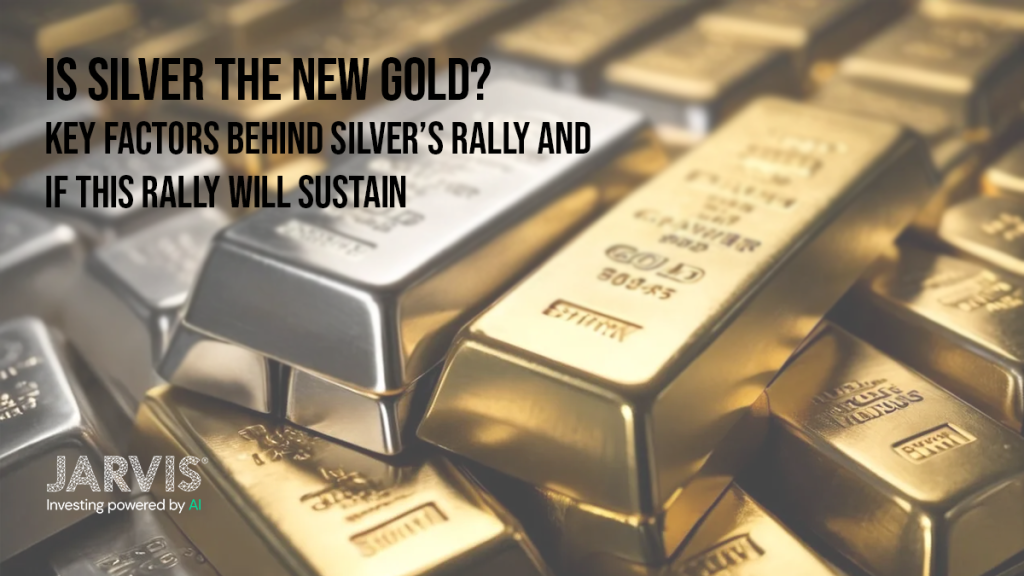Going unnoticed for many years, silver has been shining brighter lately and clients are paying attention. Unlike gold, or even oil for that matter, silver has a dual use as a precious metal on one hand and a harsh industrial commodity on the other. But is this recent rally of Silver is sustainable at all or just a fleeting trend? Now, let’s check out why silver is on the rise and what silver offers for future prospects through this latest blog: Is Silver the New Gold?
Why is Silver Rallying?
- Rising Industrial Demand
Silver does not possess the three features of gold, which is mostly used as an investment item and jewelry, unlike gold, however, silver has wide industrial applications. The component is critical in electronics, solar panels and electric vehicles (EVs). Having a global trend towards renewable energy and green technologies has created a demand for silver.
- Solar Panels – Photovoltaic cells use a key material: silver. Many of the governments all over the world are now striving for net zero carbon emissions, which has fuelled the solar energy sector driving the need for silver.
- EVs and Electronics – The adoption of EVs is at the exponential end of growth. Silver’s excellent conductivity makes it a must for EV batteries, charging infrastructure and electronic circuits.
- Inflation Hedge
Like gold, Silver is considered a hedge against inflation. Investors all over the world are flocking to tangible assets like silver, as central banks across the globe increase their interest rates and stubborn high inflation remains.
- Weaker US Dollar
Strength of US dollar is inversely related to the silver prices. That means when the dollar is weaker, silver is cheaper for international buyers increasing demand. Silver has been helped by recent dollar fluctuations pushing its price up.
- Supply Constraints
They say silver mining is losing out because of regulatory hurdles, environmental concerns and the depletion of high grade mines. Silver’s bull run is triggered by a combination of a limited supply and a rising demand.
Will the Rally Last?
While the factors propelling silver prices are strong, investors should also consider potential risks.
- Industrial Demand is cyclical
Silver’s price is more volatile than gold’s because a high percentage of the demand is from industries. The rally in silver would necessarily be tempered by any slowdown in industrial activity, regardless of the reason—due to a recession or geopolitical unrest.
- Substitution Risks
Silver is essential to many sectors and while technology advances, substitutes, or even a reduction in quantity, can be substituted. One example is that the solar industry is looking to reduce silver use in order to cut costs.
- Rising Interest Rates
Silver is an inflation hedge but that’s bad news that makes ‘non-yielding’ assets such as Silver less attractive given its negative correlation to interest rates. If rates remain elevated for a long period, investors may start to lift to high yield bonds or dividend paying stocks.
- Market Speculation
Speculative trading often influences silver prices and consequently they are subject to strong corrections in prices. Retail driven short squeezes, as we saw play out in 2021, saw periods of temporary spikes followed by drastic declines.
Silver vs. Gold for Investing, A Comparative View
| Aspect | Silver | Gold |
| Market Size | Smaller, more volatile | Larger, more stable |
| Primary Use | Industrial & Investment | Investment & Jewelry |
| Volatility | High | Low |
| Hedge | Inflation & Industrial | Primarily Inflation |
Silver’s smaller market size means price movements are more pronounced, both upwards and downwards. Its dual demand drivers industrial and investment make it more dynamic but also less predictable than gold.
Silver Investment Strategies
- Physical Silver
Dollar cost averaging in physical silver, in the form of coins and bars, is one way to gain direct exposure to its price. Storage costs as well as liquidity risks are drawbacks, however.
- Silver ETFs and Mutual Funds
That is why Exchange Traded Funds (ETFs) allow investors to buy silver prices with actually holding physical silver. They are perfect for someone who wants liquidity and convenience.
- Silver Mining Stocks
But silver prices are leveraged by investing in companies that mines silver. But it carries the risk of management inefficiency and operational hardships.
- Futures and Options
Silver futures or options can be a high risk / high reward trading strategy for the experienced investor.
Future Outlook for Silver
- Decarbonization Trends – Silver’s demand will continue to be supported as governments worldwide continue to prioritize clean energy, and this time, it’s not just solar panels and EVs.
- Emerging Markets – India and China are likely to add to silver consumption through jewelry and industrial demand, the report said.
- Technological Innovations – Silver’s unique properties could provide the opportunity to tap new technologies which could unlock additional demand.
But, of course, investors must be ready for short term volatility. Silver market will be readily navigated with the help of keeping an eye on macroeconomic indicators, industrial trends and even its monetary policies.
Conclusion
Strong fundamentals plus surging industrial demand, inflationary pressures and supply hurdles are supporting Silver’s recent rally. Gold, however, is not so volatile and is not sensitive to economic cycles, compared to silver. For the entrepreneur and the investor who both stand to greatly benefit from silver, the opportunity is real and the risk slightly less real.
If you’re hoping to offset inflation with a return on industrial growth trends, silver could be right for your portfolio. It’s important to diversify your investments and stay on a long term investing approach to squash volatility. Because of this, silver’s shine may not be lost just yet, in fact, its shine may last longer than doomsayers agree.
